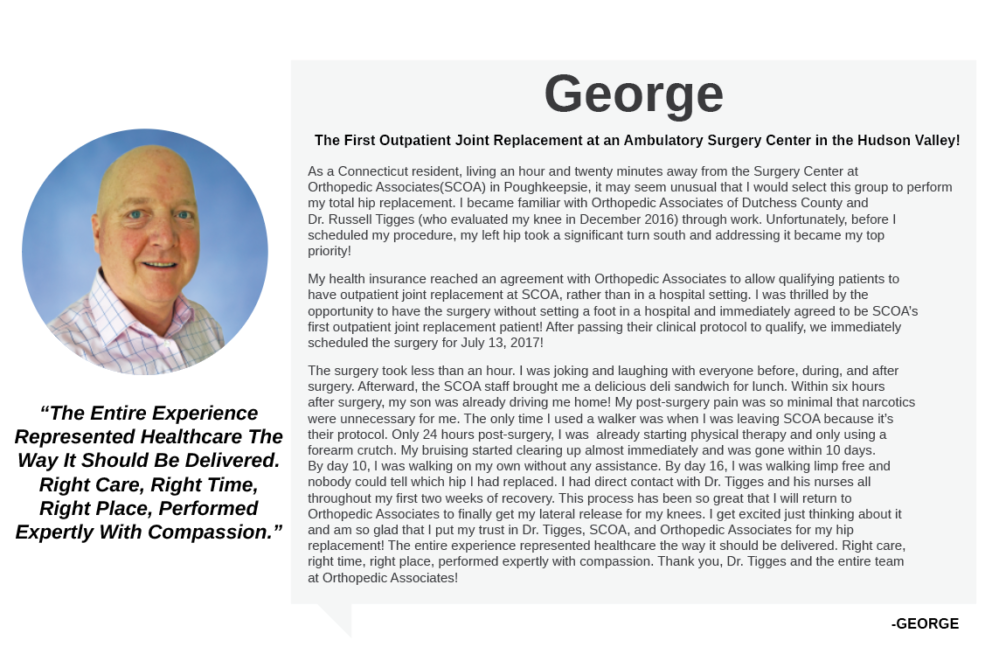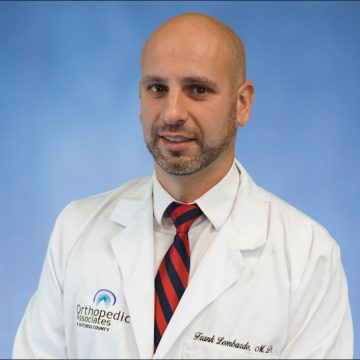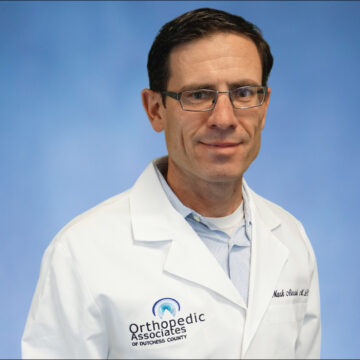
Services
Outpatient Joint Replacement
REDISCOVER YOUR HAPPINESS!
In 2017, Orthopedic Associates of Dutchess County became the first orthopedic practice in the Hudson Valley to perform outpatient joint replacement surgery at an ambulatory surgery center (ASC). This procedure was performed at the Surgery Center at Orthopedic Associates (SCOA), a state-of-the-art ambulatory surgical facility located next to our Poughkeepsie office location. As opposed to the traditional procedure, which requires a minimum one night hospital stay, the outpatient joint replacement procedure uses a technique that allows patients to go home hours after surgery. Performing outpatient joint replacements at ASCs on the appropriate patient can realize a significant cost savings to you due to lower facility costs and no overnight/long hospital stays. Studies have shown that patients who recover outside of a hospital setting also tend to be happier and more comfortable.
Meet our
Webinars
KNEE AND SHOULDER JOINT REPLACEMENT: STOP JOINT PAIN AND START LIVING!
Patient Testimonials
Meet Jesse
THE FIRST OUTPATIENT SHOULDER REPLACEMENT AT THE SURGERY CENTER AT ORTHOPEDIC ASSOCIATES!
Our Client
Meet George
THE FIRST OUTPATIENT JOINT REPLACEMENT AT AN AMBULATORY SURGERY CENTER IN THE HUDSON VALLEY!

Hip Replacement
If MLS Laser Therapy, medications, changes in your everyday activities, and the use of walking supports do not adequately help your symptoms, you may consider hip replacement surgery. Hip replacement surgery is a safe and effective procedure that can relieve your pain, increase motion, and help you get back to enjoying normal, everyday activities.
First performed in 1960, hip replacement surgery is one of the most successful operations in all of medicine. Since 1960, improvements in joint replacement surgical techniques and technology have greatly increased the effectiveness of total hip replacement. According to the Agency for Healthcare Research and Quality, more than 300,000 total hip replacements are performed each year in the United States. Whether you have just begun exploring treatment options or have already decided to undergo hip replacement surgery, our board-certified, fellowship-trained, hip replacement surgeons will be there to help you every step of the way.
The traditional surgical approach to total hip replacement uses a single, long incision to view and access the hip joint. A variation of this approach is a minimally invasive procedure in which one or two shorter incisions are used. The goal of using shorter incisions is to reduce pain and speed recovery. Unlike traditional total hip replacement, the minimally invasive technique is not suitable for all patients. Your orthopaedic surgeon will discuss different surgical options with you.
Your new hip may activate metal detectors required for security in airports and some buildings. Tell the security agent about your hip replacement if the alarm is activated. You may ask your orthopaedic surgeon for a card confirming that you have an artificial hip.
- Participate in a regular light exercise program to maintain proper strength and mobility of your new hip.
- Take special precautions to avoid falls and injuries. If you break a bone in your leg, you may require more surgery.
- Make sure your dentist knows that you have a hip replacement. Talk with your orthopaedic surgeon about whether you need to take antibiotics prior to dental procedures.
- See your orthopaedic surgeon periodically for routine follow-up examinations and x-rays, even if your hip replacement seems to be doing fine.
Knee Replacement
If nonsurgical treatments like MLS Laser Therapy, medications and using walking supports are no longer helpful, you may want to consider total knee replacement surgery. Joint replacement surgery is a safe and effective procedure to relieve pain, correct leg deformity, and help you resume normal activities.
Knee replacement surgery was first performed in 1968. Since then, improvements in surgical materials and techniques have greatly increased its effectiveness. Total knee replacements are one of the most successful procedures in all of medicine. According to the Agency for Healthcare Research and Quality, more than 600,000 knee replacements are performed each year in the United States. Whether you have just begun exploring treatment options or have already decided to undergo hip replacement surgery, our board-certified, fellowship-trained, knee replacement surgeons will be there to help you every step of the way.
The traditional approach to knee replacement uses a long vertical incision in the center of the knee to view and access the joint. Minimally invasive total knee replacement is a variation of this approach. The surgeon uses a shorter incision and a different, less-invasive technique to expose the joint-with the goal of reducing postoperative pain and speeding recovery.
Unlike traditional total knee replacement, the minimally invasive technique is not suitable for all patients. Your orthopaedic surgeon will discuss the different surgical options with you.
Most people feel some numbness in the skin around your incision. You also may feel some stiffness, particularly with excessive bending activities.
Most people also feel or hear some clicking of the metal and plastic with knee bending or walking. This is a normal. These differences often diminish with time and most patients find them to be tolerable when compared with the pain and limited function they experienced prior to surgery.
Your new knee may activate metal detectors required for security in airports and some buildings. Tell the security agent about your knee replacement if the alarm is activated. You may ask your orthopaedic surgeon for a card confirming that you have an artificial knee.
- Participate in regular light exercise programs to maintain proper strength and mobility of your new knee.
- Take special precautions to avoid falls and injuries. If you break a bone in your leg, you may require more surgery.
- Make sure your dentist knows that you have a knee replacement. Talk with your orthopaedic surgeon about whether you need to take antibiotics prior to dental procedures.
- See your orthopaedic surgeon periodically for a routine follow-up examination and x-rays, usually once a year.
Shoulder Replacement
Shoulder replacement surgery was first performed in the United States in the 1950s to treat severe shoulder fractures. Over the years, shoulder joint replacement has come to be used for many other painful conditions of the shoulder, such as different forms of arthritis.
Today, about 53,000 people in the U.S. have shoulder replacement surgery each year, according to the Agency for Healthcare Research and Quality. This compares to more than 900,000 Americans a year who have knee and hip replacement surgery.
If nonsurgical treatments like MLS Laser Therapy, medications and activity changes are no longer helpful for relieving pain, you may want to consider shoulder joint replacement surgery. Joint replacement surgery is a safe and effective procedure to relieve pain and help you resume everyday activities.
Whether you have just begun exploring treatment options or have already decided to have shoulder joint replacement surgery our skilled shoulder replacement surgeons can help!
There are several reasons why your shoulder replacement surgery may be recommended. People who benefit from surgery often have:
- Severe shoulder pain that interferes with everyday activities, such as reaching into a cabinet, dressing, toileting, and washing.
- Moderate to severe pain while resting. This pain may be severe enough to prevent a good night’s sleep.
- Loss of motion and/or weakness in the shoulder.
- Failure to substantially improve with other treatments such as anti-inflammatory medications, cortisone injections, or physical therapy.
Here are some common do’s and don’ts for when you return home:
- Don’t use the arm to push yourself up in bed or from a chair because this requires forceful contraction of muscles.
- Do follow the program of home exercises prescribed for you. You may need to do the exercises 2 to 3 times a day for a month or more.
- Don’t overdo it! If your shoulder pain was severe before the surgery, the experience of pain-free motion may lull you into thinking that you can do more than is prescribed. Early overuse of the shoulder may result in severe limitations in motion.
- Don’t lift anything heavier than a glass of water for the first 2 to 4 weeks after surgery.
- Do ask for assistance. Your physician may be able to recommend an agency or facility if you do not have home support.
- Don’t participate in contact sports or do any repetitive heavy lifting after your shoulder replacement.
- Do avoid placing your arm in any extreme position, such as straight out to the side or behind your body for the first 6 weeks after surgery.
Many thousands of patients have experienced an improved quality of life after shoulder joint replacement surgery. They experience less pain, improved motion and strength, and better function.
















